If you only walk down Rue de la Huchette, you may run screaming from Paris’ Latin Quarter. That street is just so gaudy and jammed jowl to jowl with tourists.
But the Latin Quarter isn’t just one touristy street. It’s eminently friendly and likable, if you know where to look.
Its likability doesn’t emanate from the faux Greek taverns or tacky souvenir stands in an isolated corner. No, the storied Latin Quarter is the lively heart and soul of the Left Bank.
It’s a tangle of medieval narrow streets with soulful asymmetrical architecture that seems alive. The Latin Quarter is anti-Haussmann blandness, a rare place in Paris where medieval meets modern.
The Latin Quarter is home to countless museums, gorgeous churches, storied cafes, and other historical curiosities. It’s also the hub of academic life in Paris, home to the world famous Sorbonne and the École des Beaux-Arts.
In this guide to the Latin Quarter, you’ll discover the 20+ top must visit attractions, historic landmarks, and secret hidden gems.
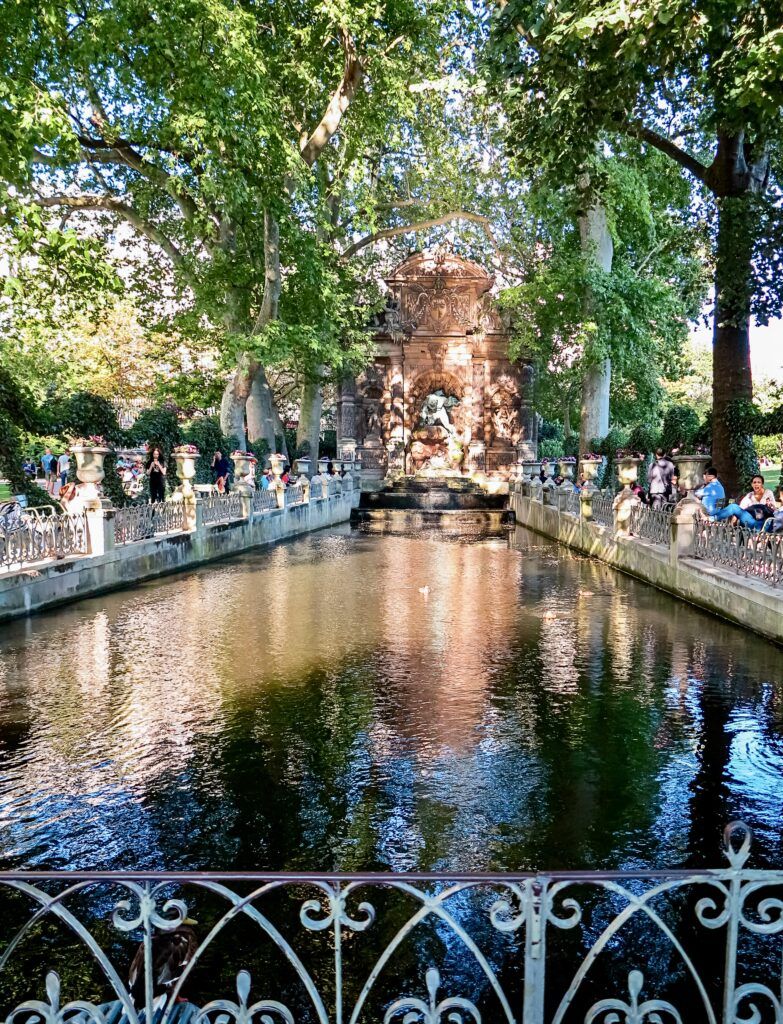
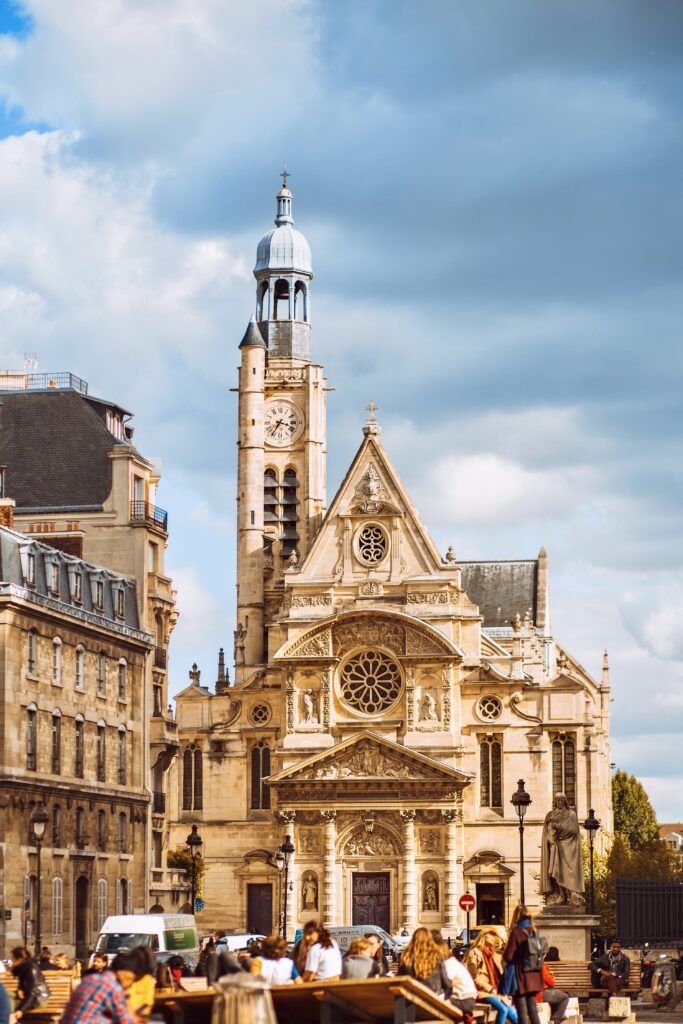
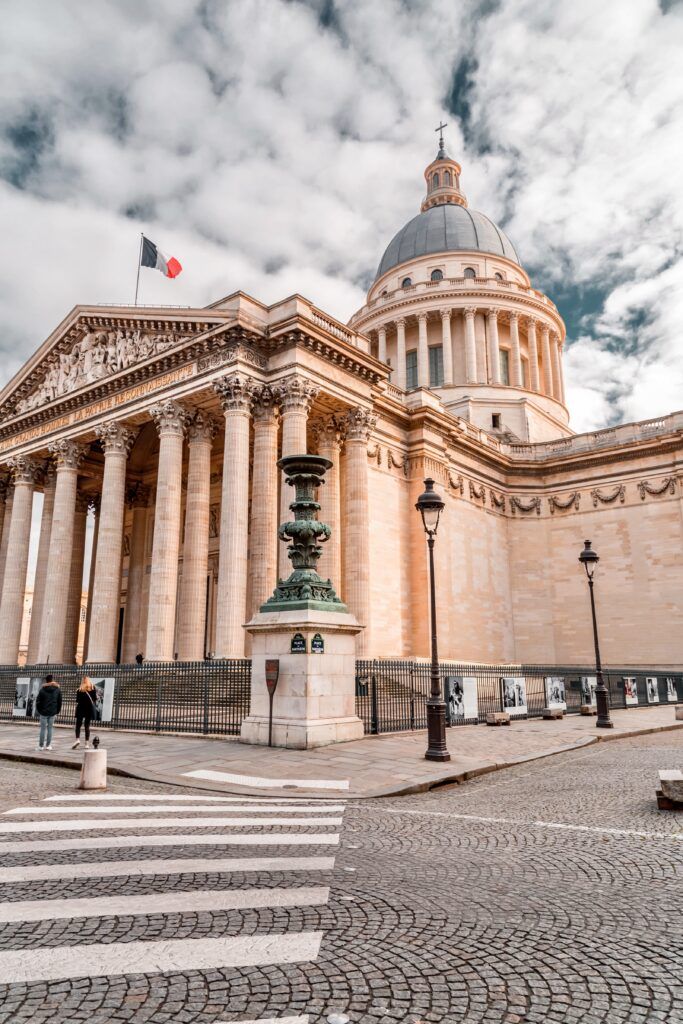
Snapshot Glance Of Things To Do In The Latin Quarter
- Saint-Severin
- Saint-Julien-le-Pauvre
- Pantheon
- Sorbonne
- College des Bernardines
- Cluny Museum
- Saint-Etienne-du-Mont
- Biblioteque Saint-Genevieve
- Luxembourg Gardens
- Arenes de Lutece
- Dali Sundial
- Curie Museum
- Delacroix Museum
- Place de la Contrescarpe
- Convent de Corderlieres
- Shakespeare & Co Bookstore
- Statue of Danton
- Odette Pastry Shop
- Grand Mosque
- Institue du Monde Arab
- Jardin des Plantes
You may want to check out some tour options:
- hidden gems bike tour
- 2.5 hour walking tour
- 3 hour private walking tour
- wine & walking tour
- writers of the Left Bank tour
Where is it? Situated on the Left Bank of the Seine River, the Latin Quarter lies in the 5th arrondissement and a small chunk of the 6th arrondissement.
Mini History of the Latin Quarter
The Latin Quarter is ancient. It’s been around for 2,000 years and was first inhabited by the Romans. Its name derives from the fact that, until the 16th century, Latin was the language of the educated elite and all that was spoken there.
Much of the district was renovated in the 19th century. But there are still pre-Haussmann vestiges to be spotted.
There’s a serious cafe culture in the Left Bank, which took off in the early 1900s. Free thinkers hung out there, enjoying the area’s creative freedom.
The Latin Quarter helped usher in the Age of Enlightenment and was the center of bohemianism. During this time, every idea was scrutinized; nothing was sacred. Even the notion of royalty was questioned.
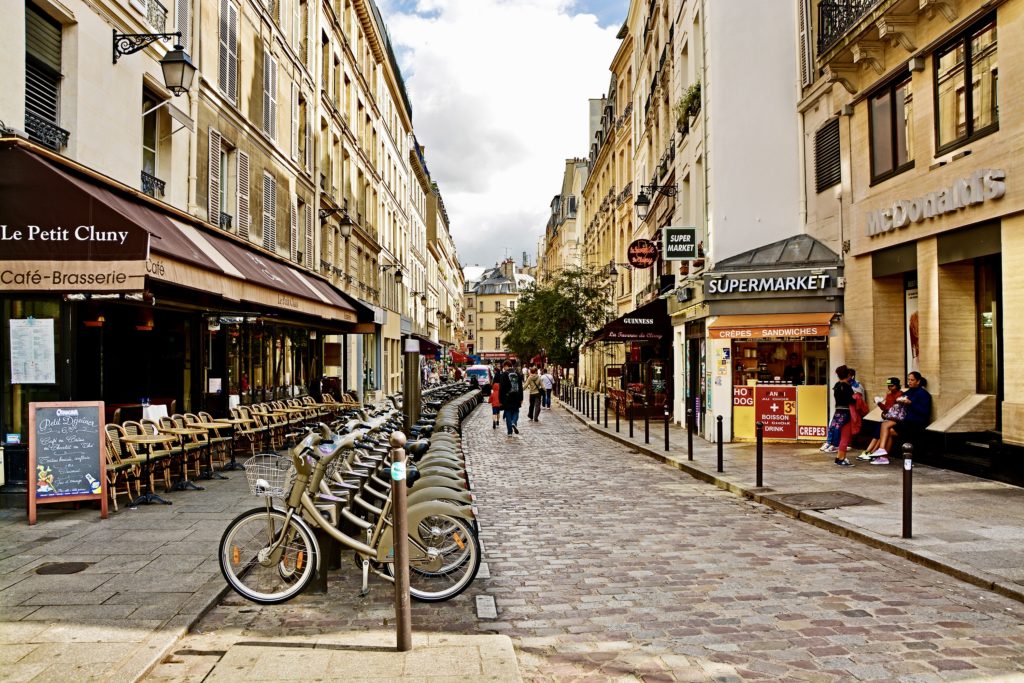
Pre-revolutionary France was governed by the wealthy. But the gap between the classes became increasingly glaring. Even Louis XIV predicted future societal issues, intoning rather pedantically, “Apres moi, la deluge,” or “after me, the flood.”
The French revolutionaries met in cafes in the Latin Quarter, like Le Precope. Robspierere, Marat, and Danton debated ideas and plotted rebellion in Revolutionary era Paris.
The rebellious culture still permeates the Latin Quarter. In 1968, the entire month of May was filled with student riots. They demonstrated against the strictures of a patriarchal society and the Vietnam War.
Top Attractions In Paris’ Latin Quarter
1. Saint-Severin Church
Set on a charming square in the Latin Quarter, Saint-Séverin is one of Paris’ most beautiful churches. It’s a quirky ancient church, dating from the 6th century.
Saint-Séverin Church, dating back to the 13th century, got its name from a devoted hermit. It blends early Gothic and Flamboyant Gothic styles, once serving as the main church of the Left Bank.
It faced fire damage during the 100 Years War. But the church was restored and is now free to visit, featuring striking gargoyles and stunning stained glass.
Inside, you’ll find unique stone pillars that arch like palm trees, with the most exquisite group in the apse. This historic church also inspired French artist Robert Delaunay, who painted its grand interior.
2. Saint-Julien-le Pauvre
Saint-Julien-le-Pauvre is reputedly the oldest church in Paris (though St. Germain des Pres also vies for that honorific). “Pauvre” means poor and the church earns its name.
The ancient church is small, with no transept or steeples. It was a refuge for pilgrims and travelers.
The stout church was demolished during the Norman invasion. But it was rebuilt in the 12th century by Benedictine monks. Saint-Julien-le-Pauvre stands in the shadow of Paris’ oldest tree, an Acadia planted in 1601.
Plain and simple, the church’s nave is austerely elegant. The choir pillars are decorated, like other Paris churches, with foliage and figures of harpies.
Many concerts take place in this modest church. Right now, the facade is undergoing restoration.
READ: The Best 15 Churches in Paris
3. Pantheon, the Academy of the Dead
The Pantheon is an iconic Latin Quarter attraction was built after a king’s near death experience It celebrates the greatest dead heros of France.
The Paris Pantheon was modeled, rather obviously, on the Roman Pantheon. With its doughty 272 foot dome, it also resembles St. Paul’s Cathedral in London.
While the exterior is Romanesque, the gigantic interior resembles a Gothic cathedral in Neoclassical from.
Its grandiose space features a vast, soaring dome that stretches overhead, allowing natural light to filter through an oculus at its apex.
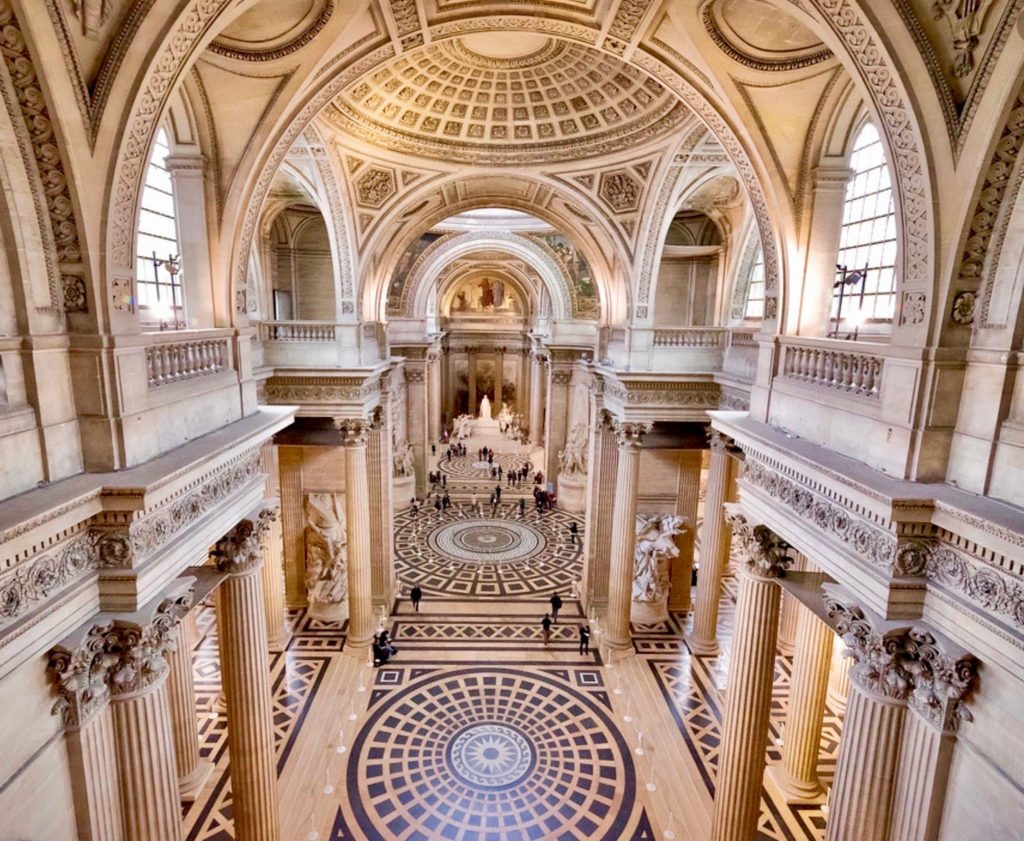
The walls are adorned with impressive frescoes and murals, depicting significant historical and allegorical scenes. They honor the rulers and religious leaders of France, telling the tempestuous history of France in the 18th and 19th centuries.
Numerous sculptures and ornate details adorn the niches and columns throughout the vast interior.
The Panthéon serves as a mausoleum for notable French figures, and visitors can also marvel at the final resting places of luminaries like Voltaire, Rousseau, Victor Hugo, and Marie Curie.
In 2020, six stunning art works by the artist Anselm Kiefer were installed.
Commissioned by Emmanuel Macron, the permanent exhibition honors writer Maurice Genevoix’s entry into the Pantheon. Genevoix is the famous author of Ceux de 14, which describes the horrors of World War I.
For more details, read my guide to the Pantheon. In high season, you’ll want to book a skip the line ticket. The Pantheon is also included in the Paris Museum Pass.
4. Sorbonne University
Paris is home to myriad prestigious universities. None is as famous as the Sorbonne University.
The Sorbonne has a storied history. It was founded 1260 by Robert de Sorbon, a 13th century French theologian.
In the middle ages, in conservative and philistine fashion, the Sorbonne stood against the Knights Templars, Protestantism, and Enlightenment philosophy. It even sent its most eminent bishop to preside over the trial of Joan of Arc.
The Sorbonne’s most famous leader and philosopher was the scheming Cardinal Richelieu. He was Louis XIII’s chief minister and an ardent Catholic.
Richelieu presided over the construction of the Sorbonne chapel in 1635, where he is now buried. Under Richelieu, the Sorbonne primarily taught theology.
During the French Revolution, religion was squashed and the Sorbonne was temporarily shuttered. Apres la deluge, things returned to normal and esteemed professors arrived for duty.
But the medieval buildings vanished. They were succeeded by Baroque buildings, finally finished in 1883.
The modern day Sorbonne is a massive place, with a plethora of lecture rooms, seminar rooms, examination halls, etc. It has 54,000 students.
5. College des Bernardines, a Rare Medieval Building in Paris
Tucked away on a little side street on Rue de Poissy, lies the the 13th century Collège des Bernardins. The abbey was built in the 13th century by Bishop Clairvaux. It served as the former residence of Cistercian Monks, who trained there for centuries until the French Revolution.
It’s a beautiful old medieval building, both inside and outside. The vaulted ceilings of what was the college refectory (dining room) are stunning. The space is approximately 1,000 square meters with 32 pillars.
In 2004-08, the college became the last medieval building to be renovated in Paris. Now, it’s used as a cultural and spiritual center, with an auditorium seating 200.
Tip: Visitors can take a tour at 4:00 pm each day.
6. Cluny Museum, National Museum of the Middle Ages
The Cluny Museum is truly one of the best museums in the Paris. It’s housed in the fully renovated Hotel de Cluny, a rare example of civic architecture in a Flamboyant Gothic style.
The museum is adjacent to an extant “frigidarium” (cold room) of a Roman bath house. The bath is the oldest preserved site in Paris.
Since 2018, the museum’s has a new entrance on Boulevard Saint Michel. It’s made of clad aluminum and striking metallic mesh, but somehow still seems to look Roman.
This museum is dedicated to all things from the Middle Ages. The Cluny’s pièce de résistance is the famous Lady and the Unicorn tapestries. It’s considered the Mona Lisa of tapestries and is one of the greatest surviving medieval relics.
Other Cluny highlights include the stained glass gallery, the corridor of tombstones, the Roman baths, the Gothic rooms, and the Notre Dame gallery.
In the Notre Dame gallery, you’ll find 21 stone heads of the kings of Judea and Israel. The full length statues originally decorated Notre Dame’s western facade.
Here’s my complete guide to the Cluny Museum.
Tickets are 12 euros (free for under 18s) and you can buy tickets online here. You also have free entry to the museum with the Paris Museum Pass.
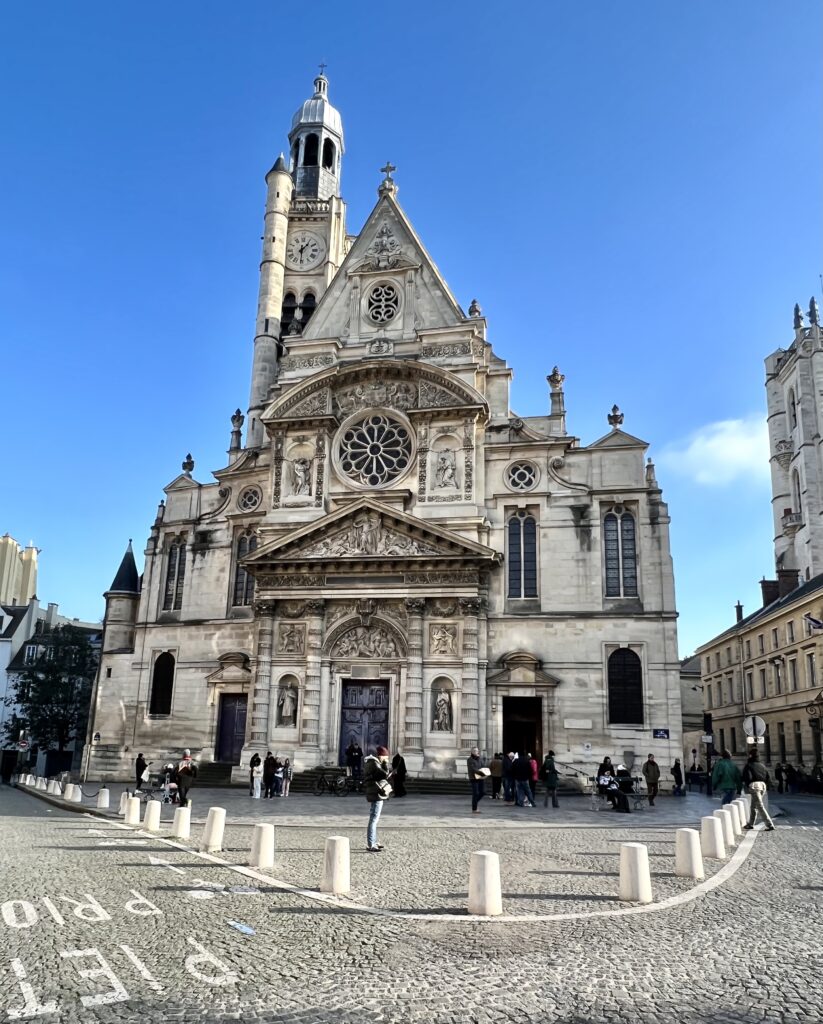
7. Saint-Etienne-du-Mont Church
Saint-Étienne-du-Mont is where Saint Genevieve, Paris’ patron saint, is buried. The church’s exterior has an unusual design with a tall belfry on one side, originally part of an abbey founded by King Clovis.
During the French Revolution, the abbey was mostly destroyed, except for the Clovis Tower, visible from the church. The church itself survived and was later restored.
Inside, you’ll find a unique rood screen separating the chancel and nave, flanked by distinctive spiral staircases – the only one of its kind in Paris. The stained glass dates back to the 16th and 17th centuries.
Saint-Étienne-du-Mont’s steps were featured in the film Midnight in Paris, launching the movie’s fantasy element.
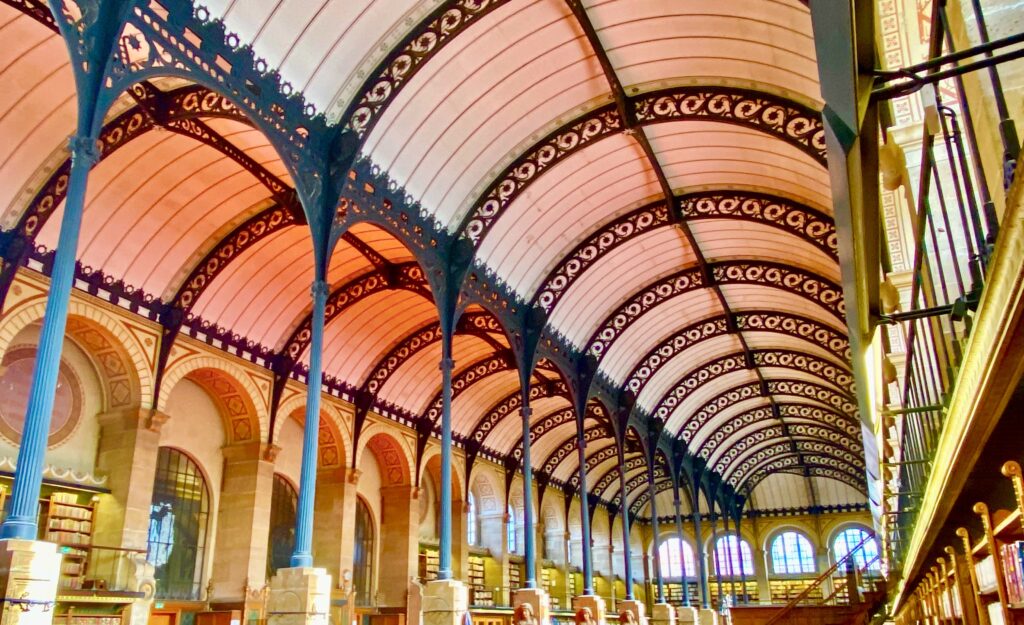
8. Bibliotheque Sainte-Genevieve
Just across from the Pantheon is the Bibliotheque Sainte-Genevieve. It was the only great monastic library that survived the French Revolution.
It has a fine collection of medieval manuscripts and a beautiful reading room with iron trusses supporting an arched roof.
You can visit for free Monday to Saturday from 2:00 pm to 6:00 pm. You can see the frescoed entrance vestibule, the staircase of honor, the cabinet of curiosities, and have a peak at the reading room.
9. Luxembourg Gardens: A Leafy Pantheon
Luxembourg Gardens is one of Paris’ ever-so-pretty green spots, full of architectural delights. It’s essentially an outdoor sculpture museum.
Dating from 1612, the sun-speckled gardens feature heavily in Victor Hugo‘s romantic novel Les Miserables. They were frequented by the real life philosophers Jean-Paul Sartre and Simone de Beauvoir.
Marie de Medici, Henry IV’s widow, commissioned the Luxembourg gardens in the 1630. They were styled to emulate the Boboli Garden of the Pitti Palace in Florence.
The crowning glory is the incredibly romantic Medici Fountain. It’s a grotto-like monument designed to emulate water seeping from the stones.
You’ll also see sculptures and busts of Eugene Delacroix, George Sand, Stendahl, and Beethoven.
To see it all, you can book a 2 hour tour of the gardens.
Tip: During the summer months, you can rent miniature sailboats and sail them across the Luxembourg’s central fountain feature.
10. Arènes de Lutèce: Roman Paris
The Arenes de Lutece is another wonderful attraction in the Latin Quarter. Lutetia or Lutece was one of Paris’ first official names. It used during the Gallo-Roman period.
Built around 200 A.D., it was one of the largest Roman amphitheaters in Roman Gaul, though not as large as the ones you’ll find in southern France. The Arena seated around 15,000.
Over the centuries, it was buried under expansion detritus and used as a graveyard. In 1869, the arena was re-discovered during the Haussmann construction of Rue Monge. As with Notre Dame Cathedral, a group led by Victor Hugo rescued Arenes de Lutece from the city planner’s wrecking ball.
Today, little remains of the original grand amphitheater. What you see is only 1/3 of its original size. The arena is mostly used by teenagers playing soccer.
11. The Salvador Dali Sundial
I confess I have a soft spot for Salvador Dali. Though he made his name as an eccentric showman, the man could flat out draw. When he arrived in Paris in 1926, he joined the Surrealist movement.
On Rue Saint-Jacques, you’ll find a unique piece of his street art — a Salvador Dali sundial. It depicts the head of a woman in the shape of a shell.
There’s also a small Espace Dali museum in Montmartre. And the massive “Shh!” mural near the Pompidou Center.
If you’re interested in Paris street art (a massive subject on its own), you can also find some works of Banksy in the Latin Quarter.
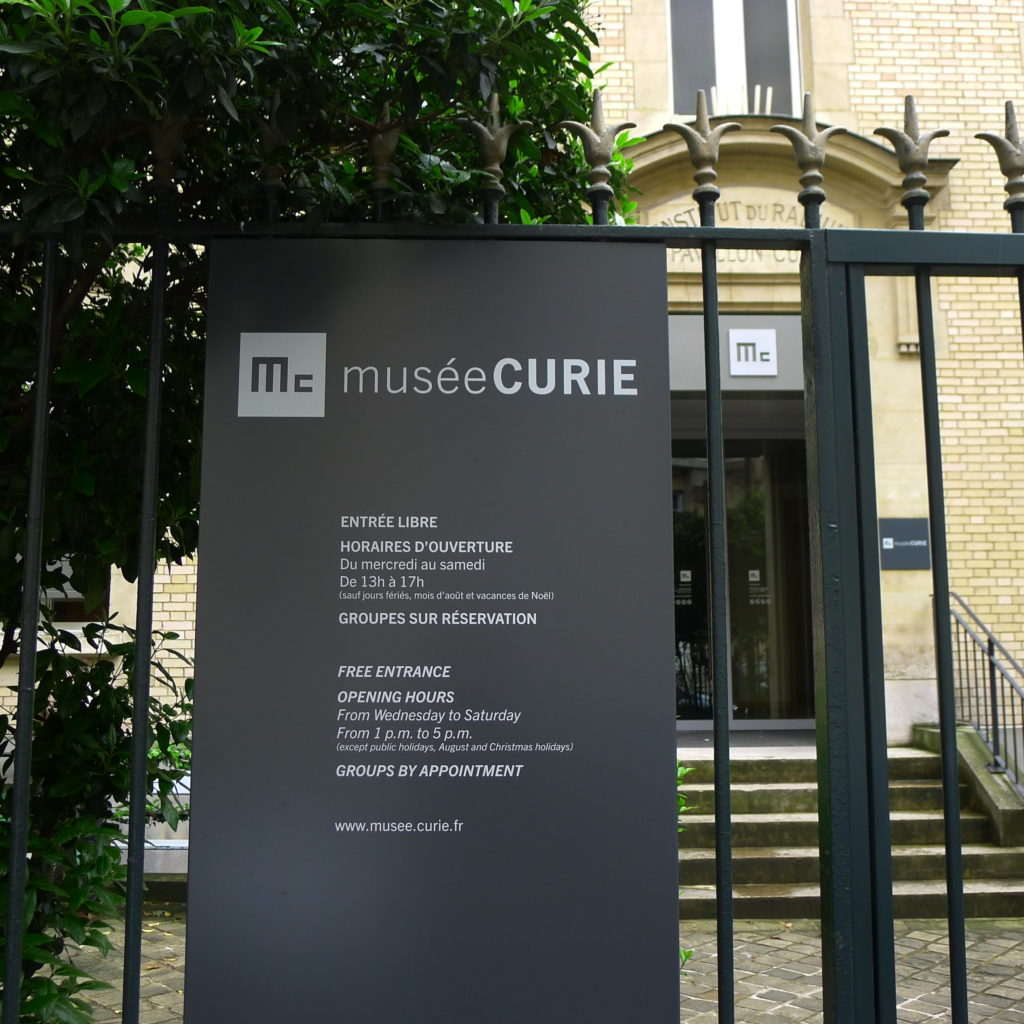
12. Curie Museum: Get Your Geek On
The Curie Museum celebrates the life of scientist Marie Curie — what a woman! It’s located near the Pantheon in the 5th arrondissement.
Curie was the first woman to receive a Nobel Prize. And she’s the only person in history to have won a Nobel Prize in two different scientific fields, physics and chemistry, in 1903 and 1911.
The permanent exhibition of her eponymous museum traces the history of radioactivity and its medical applications. It also gives you an overview of the lives and works of Curie, her husband Pierre, and their children, Irene and Frederi.
The Curies are dubbed “the family of 5 Nobel prizes.” The museum got a facelift in 2012, courtesy of Curie’s daughter.
You’ll find a chemistry laboratory that houses laboratory notes and scientific instruments from 1930. I especially loved Curie’s small office where she spent most of her time.
13. Musée National Eugène Delacroix
Bordering the Latin Quarter and the tonier Saint-Germain-des-Pres neighborhood is the Eugene Delacroix Museum, on the gorgeous Place de Furstenberg.
This is an eccentric little gem of museum. It’s off the beaten track gem that’s one of the best things to do in the Latin Quarter for art lovers. When I last visited, it was nearly empty.
It has an intimate setting, housed in Delacroix’s final apartment and studio before his death in 1863.
Delacroix is known as the founder of the Romantic Period of painting. You won’t see anything as stunning as Delacroix’s famous Liberty Leading the People (that draws massive crowds at the Louvre) at his studio.
What you’ll find is lush religious and historical paintings and drawings by Delacroix and others, as well as personal objects and mementos.
Delacroix had an obsession with large cats, and you’ll see some of those paintings too.
14. Place de la Contrescarpe & Rue Mouffetard
Just down the hill form the Pantheon is the Place de la Contrescarpe. It’s a lively square, flanked by cafes and restaurants far removed from Paris grand boulevards. A flowing fountain sits in the center amid lush trees.
In the summer, musicians play music. The square is located along the vibrant Rue Mouffetard, one of Paris’ oldest streets with haphazard crooked cobblestones and food stalls. In another life, it was the main road of Roman Lutecia.
Place de la Contrescarpe is perhaps most famous as the setting for the opening scene of Ernest Hemingway’s famous novel, A Moveable Feast. In the 1920s, Hemingway took up residence at 74 rue du Cardinal-Lemoine.
Though the area is now quite gentrified, then it was a working class neighborhood of craftsman. And it doesn’t seem entirely refined now, which lends to its traditional charm.
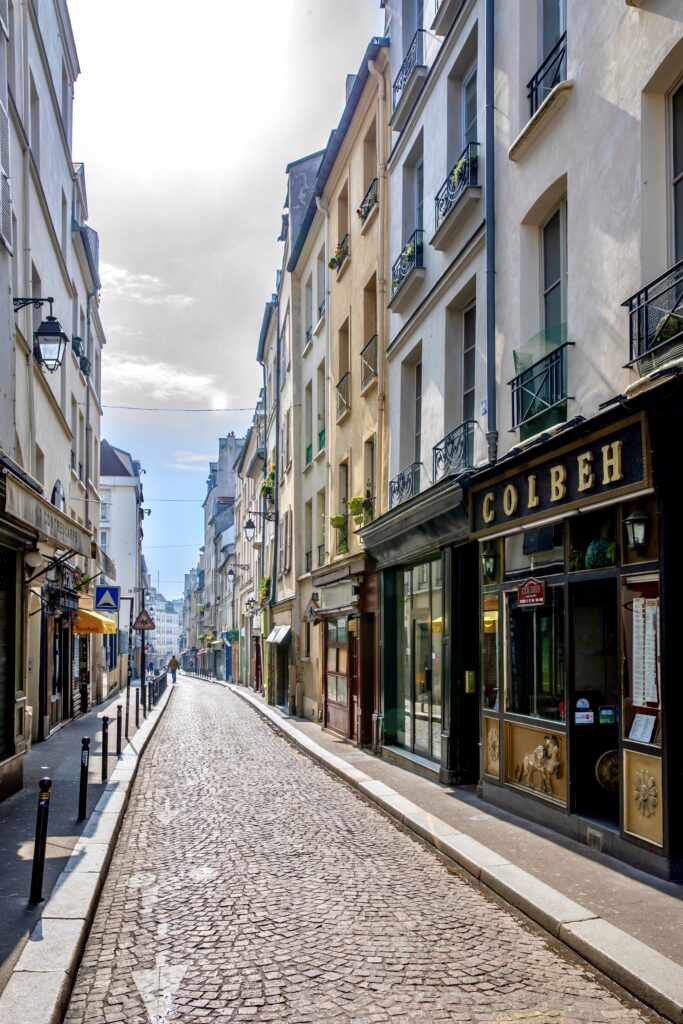
Hemingway romanticized his “poor but happy life” in the district. He famously penned the phrase: “If you are lucky enough to have lived in Paris as a young man, then wherever you go for the rest of your life, it stays with you, for Paris is a moveable feast.”
Hemingway wasn’t the only expatriate luminary living there.
Victor Hugo set scenes from Les Miserables there. George Orwell was there, writing Down and Out in Paris and London.
James Joyce completed Ulysses there. Julia Child loved the market on Rue Mouffetard. The film about her life, Julia and Julia starring Meryl Streep, shows her shopping there.
15. Remains of the Convent des Cordelieres
Continuing along Rue Moufftard, you will come across the remains of the Convent des Cordelieres.
It was founded in the 16th century and belonged to the Franciscan order of the Poor Clares, an order of nuns. The convent gained historical significance due to its association with notable figures such as Marguerite de Navarre, the sister of King Francis I, who resided there.
It’s also known for being the place where the philosopher and theologian Pierre Abélard sought refuge in the 12th century after his controversial relationship with Héloïse d’Argenteuil.
The vestiges of the convent stand in the garden of the present day Broca Hospital.
16. Shakespeare & Company & Abbey Bookstore
Facing the Seine, Shakesapeare and Company is the most famous English language bookstore in Paris. It’s always a fun spot to visit and one of the most popular things to do in the Latin Quarter. You’ll likely encounter a line to get in.
You can browse for books. Upstairs is a reading room and library with comfy nooks to curl up with a good book.
There’s a cafe right next door, owned by the bookstore, should you need a coffee or pastry.
Located in the Hotel Dubuisson, the Abbey Bookstore is another charming anglophone bookstore. It sells new, vintage, and rare books, lovingly offered up in massive floor to ceiling piles.
The bookstore also serves up coffee and the delicious smell wafts among the books.
You’ll find the Abbey Bookstore on Rue de la Parcheminerie, a tiny lane dating back to the 13th century.
17. Statue of Danton, Giant of the French Revolution
I love this statue of the French Revolutionary Georges-Jacques Danton. The expressive piece seems to capture the very essence of the larger than life figure.
It exudes the revolutionary fervor of the time, when political convulsion gripped France and then reverberated around the world.
Danton was one of the driving forces of the French Revolution, which put an end to monarchs raising their bejeweled fingers in command. Danton was an orator whose impassioned speeches drove reformers to take action.
Unfortunately, the revolution quickly escalated into the Reign of Terror. Maximilien Robespierre seized control and the guillotine was his weapon of choice.
When Danton protested the extremes, he too lost his head. On the block, Danton told his executioner: “Make sure you show it to the people. It is worth a look.”
18. Odette Pastry Shop
Foodies should visit Odette Pastry Shop. The bakery is a famous instagrammable spot in Paris, right next to a rare green half timbered building in Paris.
The shop is just steps away from Saint Severin and behind Shakespeare & Co. bookstore. It specializes in cream puffs, but has an extensive menu.
If you’re adventurous and it’s the right season, try the passion fruit or champagne puff.
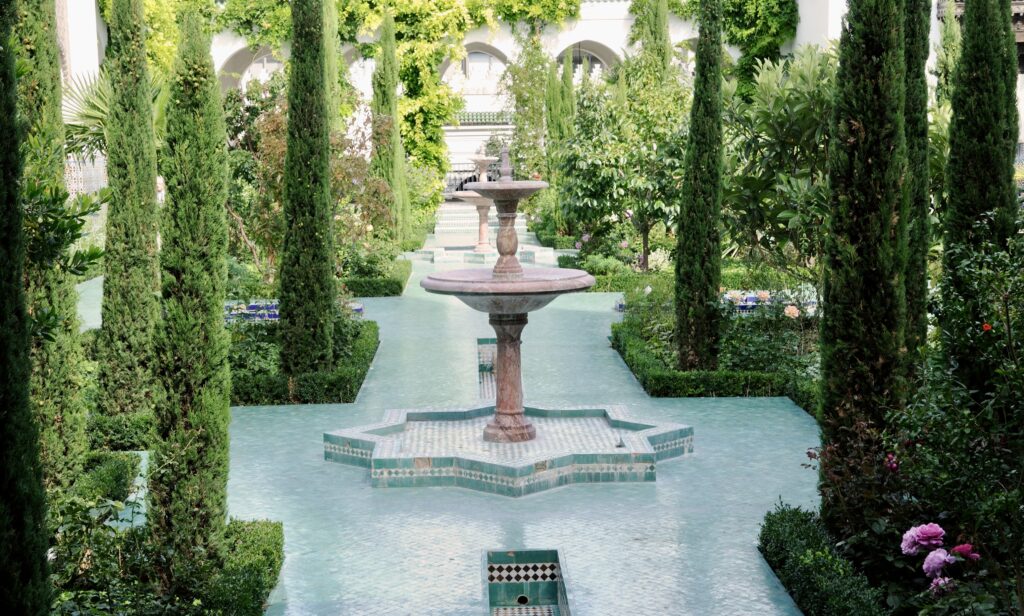
19. Grande Mosque de Paris
The Grande Mosque de Paris is the principal religion center for Paris’ Muslim community.
The mosque was built between 1922-1926 in a composite Moorish style. Its calling card is a striking green and white minaret that’s 65 feet tall.
The most gifted artisans from northern Africa were hired to decorate the building with mosaics, tiles, and marbles. The grand patio features woodwork, mosaics, and a beautiful fountain. It was inspired by the Alhambra in Granada.
The mosque is open to the public. You’ll just have to take your shoes off to enter. It also has a popular tea room, which serves mint tea and Moroccan food in an idyllic Moorish setting.
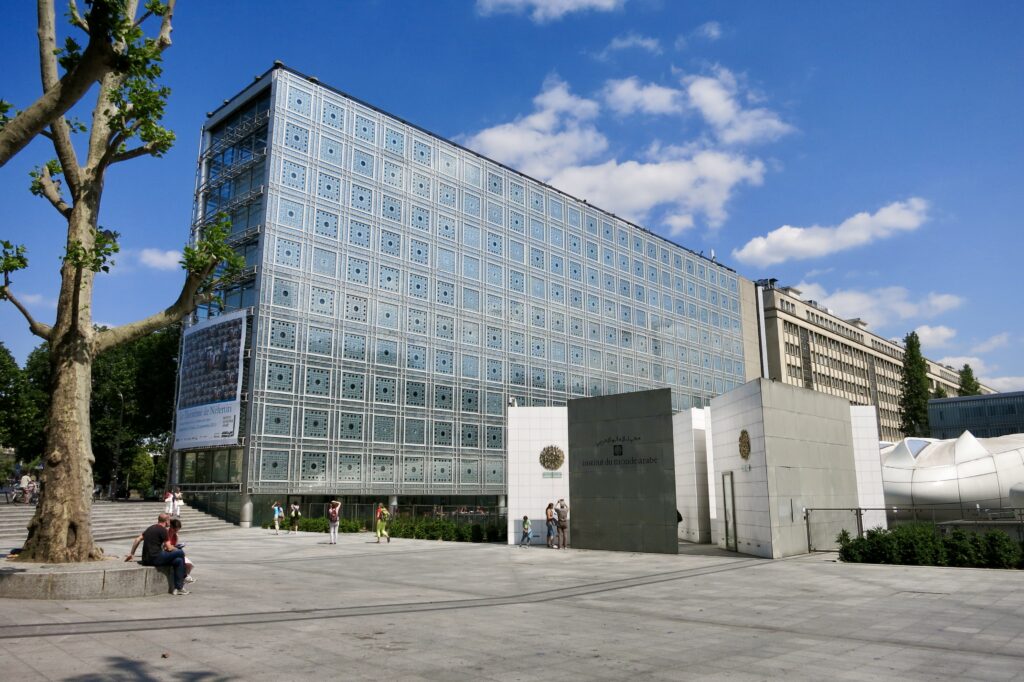
20. Institute du Monde Arabe
Inaugurated in 1987, the Institute du Monde Arabe is an amazing glass and steel building designed by Jean Nouvel. (He also designed the Quai Branley-Chirac Museum.) The sleek facade has 1,600 aluminum prisms that open and close to regulate sun coming the building.
The building was the product of a joint Franco-Arab project intended to encourage cultural links between the West and the Arab world.
The building has permanent and temporary exhibitions spaces, a library, bookstore, and auditorium. The permanent collection showcases the scientific and cultural achievements of Arab scientists.
It also has a rooftop cafe that offers up spectacular views of the Seine and Notre Dame. This alone makes it one of the top attractions in the Latin Quarter.
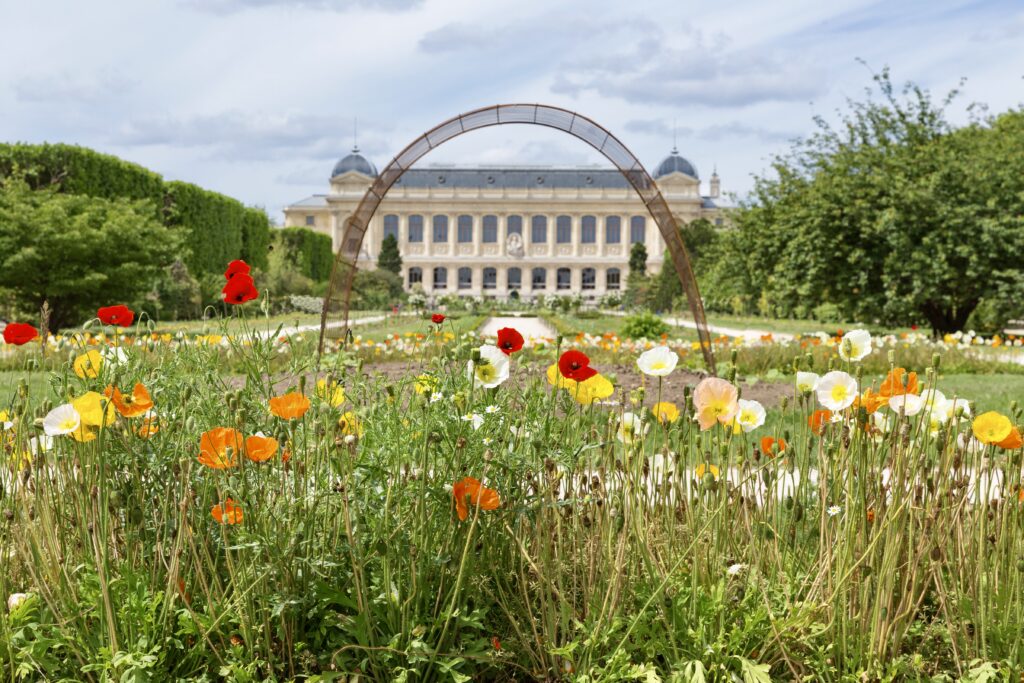
21. Jardin Des Plantes
The Jardin des Plantes is another excellent attraction in the Latin Quarter, a place where you can escape the city buzz.
It was originally founded in 1635 as the royal medicinal garden of Louis XIII. The gardens were later expanded in 1739 by Georges Buffon. They have since been renovated and reopened to the public in 2010.
There are three majestic avenues lined with trees, three greenhouses, a menagerie, bronze gazebo, and 18th century labyrinth. The menagerie (or zoo) is classified as a history monument.
The gardens are on the grounds of Paris’ Natural History Museum. It’s an old world museum featuring the evolution of animals. You’ll find the usual whale skeleton, taxidermied animals, and animal-centric interactive displays.
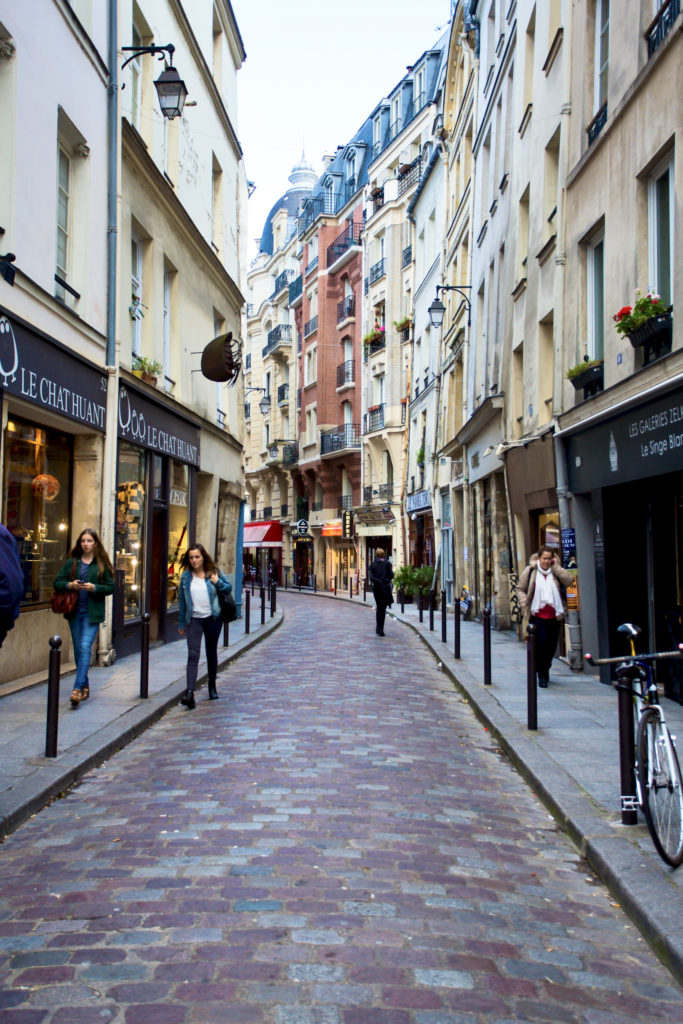
Where To Stay In The Latin Quarter
The Latin Quarter is brimming with excellent hotels, including some hip boutique hotels.
Hotel le Lapin Blanc is a pretty hotel with pastel shades near the Luxembourg Gardens. At the beautifully renovated Hotel Monge, the decor offers numerous nods to literary Paris.
The Hotel d’Aubusson is a fantastic hotel with old world charm near the Seine. The Esprit Saint Germain is a warm boutique hotel with an authentic Parisian vibe. The Hotel de Buci is a sumptuous boutique hotel inspired by 18th century designs.
One of my favorite hotels is the beautiful Relais Christine. It’s a discreetly luxurious boutique hotel in a Paris mansion.
I hope you’ve enjoyed my guide to the top attractions in the Latin Quarter. You may enjoy these other Paris travel guides:
- 5 Day Itinerary for Paris
- 3 Day Itinerary for Paris
- 2 Day Itinerary for Paris
- Tips for Planning a Trip to Paris
- Tourist Traps To Avoid In Paris
- Top Attractions in Montmartre
- Top Attractions in the Marais
- Best Museums In Paris
- Hidden Gems in Paris
- Best Things To Do in Paris in Winter
- Guide to the Opera District
- Secret day trips from Paris
Pin it for later.

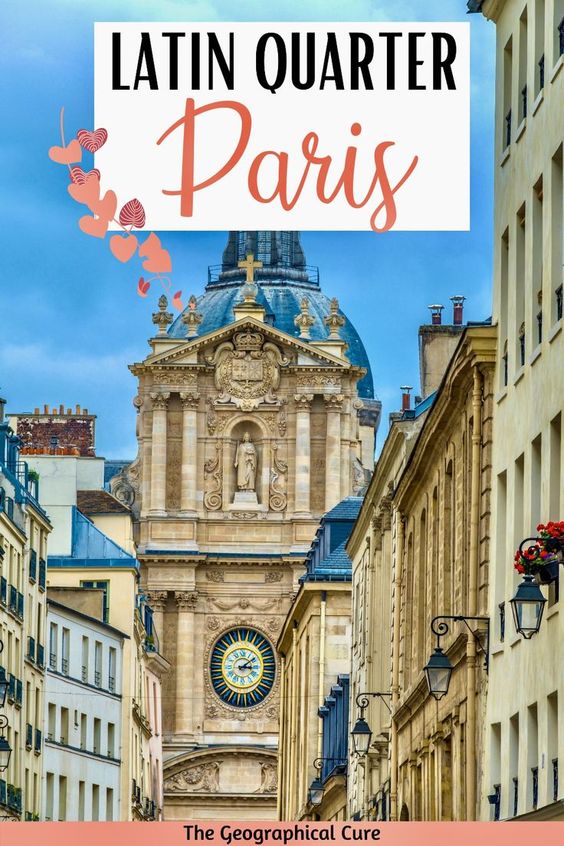
I must compliment you…this is one of the best ‘blogs’ I have found in my search for what to do in 2 weeks in Paris. My wife and I are taking the Viking France’s Finest cruise15 days. Since we are traveling so far, and probably for the last time (cruise in 2024 – 78 years old too).
About Shakespeare and Company. In 1986 I went to Paris and had already looked up the history of the famous book store. I knew that George Whitman was the owner so when I visited, I asked if I if I could speak to him. The clerk sent me upstairs. George was at his desk and welcomed me warmly. The then I told him that, being a Whitman from Massachusetts, I was his son. I will never forget the look on his face — only for a few seconds. He jumped up and embraced me with tears of laughter streamimg down his cheeks. Good thing he had a good sense of humor. I will return to meet Sylvia Beach Whitman in 2024. Thank you for this excellent information…particularly about botique hotels.
Thank you so much Stanley! I hope you have a divine time.